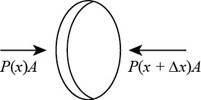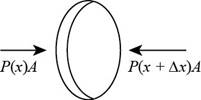
Concept explainers
(a)
To draw: The force diagram for this element showing the force exerted on the left and the right surface.
(a)
Answer to Problem 60CP
The force diagram for this element showing the force exerted on the left and the right surface is

Explanation of Solution
Introduction: Force diagram contains all the forces acting on the body. It contains the direction of the each force acting on the body represents at its top and bottom end or left and right sides.
The force diagram for this element showing the force exerted on the left and the right surface is shown below.

Figure (1)
The force diagram of the element of gas in Figure (1) indicates the force exerted on the right and left surfaces due the pressure of the gas on the either side of the gas.
(b)
To show: The expression,
(b)
Answer to Problem 60CP
The expression
Explanation of Solution
Let
The net force to the right on the chunk of air in Figure (1) is,
The force due to atmosphere is,
Here,
Differentiate the equation (1) with respect to
Formula to calculate the mass of the air is,
Here,
Formula to calculate the acceleration is,
Here,
From Newton’s second law, formula to calculate the Force is,
Substitute
Conclusion:
Therefore the expression,
(c)
To show: The wave equation for sound is
(c)
Answer to Problem 60CP
The following wave equation for sound is
Explanation of Solution
Given info: The value of the
From part (b), the given expression is,
Substitute
Thus, the wave equation for sound is
Conclusion:
Therefore, the wave equation for sound is
(d)
To show: The function
(d)
Answer to Problem 60CP
The function
Explanation of Solution
The given wave equation is,
Apply the trial solution in the above equation.
Double differentiate the equation (1) with respect to
Double differentiate the equation (1) with respect to
The wave equation for sound in part (c) is,
Substitute
Thus, the function
Conclusion:
Therefore, the function
Want to see more full solutions like this?
Chapter 16 Solutions
Bundle: Physics For Scientists And Engineers With Modern Physics, Loose-leaf Version, 10th + Webassign Printed Access Card For Serway/jewett's Physics For Scientists And Engineers, 10th, Single-term
- A pendulum bob A (0.5 kg) is given an initialspeed of vA = 4 m/s when the chord ishorizontal. It then hits a stationary block B (1kg) which then slides to a maximum distanced before it stops. Determine the value of d.The coefficient of static friction between theblock and the plane is μk = 0.2. The coefficientof restitution between A and B is e = 0.8.Ans: d=1.0034 marrow_forwardFigure 29-43 Problem 12. ••13 In Fig. 29-44, point P₁ is at distance R = 13.1 cm on the perpendicular bisector of a straight wire of length L = 18.0 cm carrying current i = 58.2 mA. (Note that the wire is not long.) What is the magnitude of the magnetic field at P₁ due to i? P2° R R Larrow_forwardCheckpoint 1 The figure shows the current i in a single-loop circuit with a battery B and a resistance R (and wires of neg- ligible resistance). (a) Should the emf arrow at B be drawn pointing leftward or rightward? At points a, B C R b, and c, rank (b) the magnitude of the current, (c) the electric potential, and (d) the electric potential energy of the charge carriers, greatest first.arrow_forward
- 3. If the force of gravity stopped acting on the planets in our solar system, what would happen? a) They would spiral slowly towards the sun. b) They would continue in straight lines tangent to their orbits. c) They would continue to orbit the sun. d) They would fly straight away from the sun. e) They would spiral slowly away from the sun. 4. 1 The free-body diagram of a wagon being pulled along a horizontal surface is best represented by A F N B C 0 Ꭰ FN E a) A b) B c) C app app The app 10 app d) e) ס ח D E 10 apparrow_forwardPls help ASAParrow_forwardPls help asaparrow_forward
 Principles of Physics: A Calculus-Based TextPhysicsISBN:9781133104261Author:Raymond A. Serway, John W. JewettPublisher:Cengage Learning
Principles of Physics: A Calculus-Based TextPhysicsISBN:9781133104261Author:Raymond A. Serway, John W. JewettPublisher:Cengage Learning Physics for Scientists and Engineers, Technology ...PhysicsISBN:9781305116399Author:Raymond A. Serway, John W. JewettPublisher:Cengage Learning
Physics for Scientists and Engineers, Technology ...PhysicsISBN:9781305116399Author:Raymond A. Serway, John W. JewettPublisher:Cengage Learning Physics for Scientists and EngineersPhysicsISBN:9781337553278Author:Raymond A. Serway, John W. JewettPublisher:Cengage Learning
Physics for Scientists and EngineersPhysicsISBN:9781337553278Author:Raymond A. Serway, John W. JewettPublisher:Cengage Learning Physics for Scientists and Engineers with Modern ...PhysicsISBN:9781337553292Author:Raymond A. Serway, John W. JewettPublisher:Cengage Learning
Physics for Scientists and Engineers with Modern ...PhysicsISBN:9781337553292Author:Raymond A. Serway, John W. JewettPublisher:Cengage Learning Physics for Scientists and Engineers: Foundations...PhysicsISBN:9781133939146Author:Katz, Debora M.Publisher:Cengage Learning
Physics for Scientists and Engineers: Foundations...PhysicsISBN:9781133939146Author:Katz, Debora M.Publisher:Cengage Learning Glencoe Physics: Principles and Problems, Student...PhysicsISBN:9780078807213Author:Paul W. ZitzewitzPublisher:Glencoe/McGraw-Hill
Glencoe Physics: Principles and Problems, Student...PhysicsISBN:9780078807213Author:Paul W. ZitzewitzPublisher:Glencoe/McGraw-Hill





